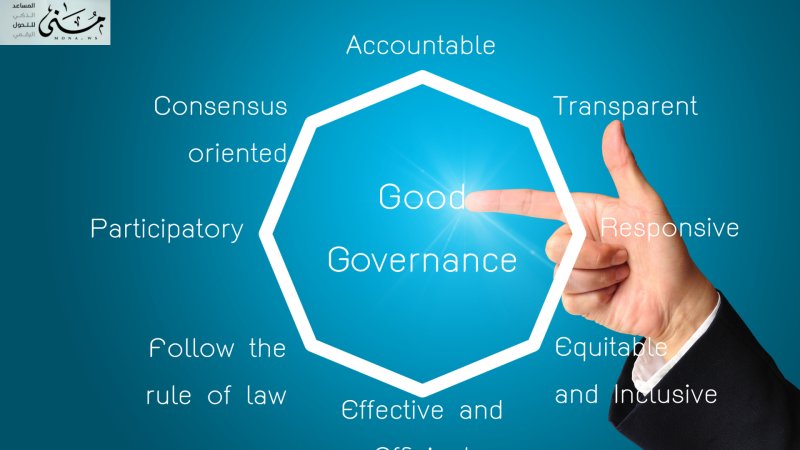Governance plays a fundamental role in the success and sustainability of organizations, as it enhances investor confidence and improves institutional performance. With the increasing complexity of the business environment, governance assessment has become an imperative to ensure efficient operations and reduce risks.
In this article, we review the importance of governance assessment, the criteria for measuring it, the most prominent challenges facing institutions, and the latest systems that can be relied upon to enhance compliance and transparency.
The concept of governance assessment and its importance
Governance assessment is the process of analyzing the extent to which organizations adhere to the basic principles of governance, such as transparency, accountability, fairness, and responsibility. This assessment aims to improve the organization's performance, reduce risks, and enhance the confidence of investors and stakeholders.
Good governance plays a vital role in achieving business sustainability, ensuring that operations are conducted within specific controls that prevent corruption and support sound strategic decision-making.
When evaluating governance, several key aspects are analyzed, such as the effectiveness of the board of directors, the independence of oversight committees, and the clarity of policies and procedures.
This analysis helps identify strengths and weaknesses within the organization, enabling management to take immediate corrective steps. Therefore, governance assessment is an essential tool for any organization seeking growth and sustainability in an increasingly complex competitive environment.
Governance Evaluation Indicators
What cannot be measured cannot be improved, and therefore there is a set of indicators that can be relied upon to evaluate governance within institutions. These indicators include:
The extent of the independence of the Board of DirectorsThere should be a balance between executive and non-executive members, to ensure unbiased decisions are made.
Transparency and financial disclosureThe extent to which the institution is committed to publishing financial reports clearly and in a timely manner.
Level of compliance with regulations and legislationThe company's commitment to local and international laws regulating its work.
Risk management efficiencyThe extent to which an organization is able to identify and address risks effectively.
Stakeholder engagement:Includes the extent to which the company interacts with shareholders, employees, customers, and the community.
These indicators contribute to providing a clear picture of the extent of the organization’s commitment to good governance practices, which helps in guiding strategic decisions and achieving organizational goals efficiently.
How to evaluate governance
Governance is assessed through a set of criteria that cover various aspects of governance, from board performance to risk management mechanisms and regulatory compliance, such as:
Evaluation of the structure and performance of the Board of Directors
The Board of Directors is one of the most important elements that determine the quality of governance within the organization. Governance is evaluated through:
Council compositionDoes the board include independent members with sufficient experience?
Effectiveness of specialized committees: Such as the Audit, Risk and Remuneration Committee, and its role in making strategic decisions.
Meetings and decision makingAre meetings held regularly? Are decisions made based on clear, informed data?
Transparency and financial disclosure
One of the most important criteria for evaluating governance is the extent to which the institution is committed to clearly disclosing its financial and administrative information. This includes:
Audited Financial Reports: Ensure that there is an independent review of the financial statements.
Disclosure of material information: Such as strategic plans, potential risks, and company performance.
Conflict of Interest Avoidance PoliciesDoes the company have clear policies to ensure that some parties do not benefit at the expense of others?
Risk Management and Compliance
Good governance requires a robust system of risk management and compliance with regulatory standards, including assessment of:
Having clear risk management policiesDoes the organization have strategies to address financial and operational challenges?
Compliance SystemDoes the company comply with local and international laws and regulations?
Protecting the rights of shareholders and stakeholdersAre shareholders involved in important decisions?
Using Technology in Governance Assessment
With the digital development, there are advanced technical tools that help improve governance assessment, such as systemsDocSuite and SAP GRC provide intelligent document management, enhance regulatory compliance, and facilitate audits and reviews.
These systems provide integrated dashboards to monitor governance performance within the organization, facilitating informed and effective decision-making.
Governance is assessed through a set of criteria that include the performance of the board of directors, the level of transparency and disclosure, the efficiency of risk management, and the extent of the use of technology to improve compliance and control. Organizations that invest in assessing and improving governance achieve a strong competitive advantage and ensure their sustainability in a changing business environment.
Reliable systems for governance assessment
With the development of technology, there are many systems that help institutions evaluate and improve governance. The most prominent of these systems are:
systemGRC (Governance, Risk and Compliance):Provides integrated tools to manage risk and ensure compliance with regulatory standards.
Doc Suite SystemDocSuite):It is one of the most advanced systems in document management and administrative communications, which contributes to enhancing transparency and operational efficiency.
systemSAP GRC:Helps organizations effectively assess risks and comply with global standards.
systemOracle Governance, Risk, and Compliance:Provides accurate analytical reports to support governance decisions.
The use of these systems not only contributes to improving the level of governance within institutions, but also helps facilitate internal auditing processes, save time, and reduce human errors, which enhances the efficiency of operations and decision-making.
How do organizations achieve excellence through good governance?
To achieve organizational excellence, organizations must adopt a proactive approach to governance management, which includes:
Promote a culture of governance within the organizationEmployees should be fully aware of the importance of governance and their role in achieving it.
Develop clear policies and procedures.: Having clear policies that facilitate compliance and assessment processes.
Using Technology to Support Governance:Smart systems help in implementing governance processes efficiently and quickly.
Periodic evaluation and continuous updatingGovernance assessment should be an ongoing process to ensure adaptation to new changes in the business environment.
When organizations adopt these practices, they not only ensure compliance with regulatory standards, but they put themselves in a strong competitive position to achieve sustainable success, enhance their reputation in the market, and build long-term trust with all stakeholders.
Governance assessment is not just a routine procedure, it is a critical component of the success of modern organizations. When governance assessment is implemented effectively, it helps improve organizational performance, enhance transparency, and reduce risks, which positively reflects on all aspects of the business.
The difference between good governance and poor governance
Good governance plays a fundamental role in the success and sustainability of organizations, as it relies on the principles of transparency, accountability, and adherence to ethical standards, which leads to wiser strategic decisions and effective risk management.
Conversely, weak governance can lead to lack of clarity within the organization, mismanagement, and increased potential for corruption, exposing it to significant financial and legal risks.
For example, companies with strong governance standards have independent boards of directors, strict internal control systems, and transparent financial disclosure mechanisms.
Companies with weak governance may face problems such as conflicts of interest, misallocation of resources, or non-compliance with regulations and laws, which may ultimately lead to their collapse or loss of confidence from investors and customers.
In the future, governance standards are expected to become more stringent, with increased regulatory scrutiny and the use of data analytics technologies to more accurately monitor administrative and financial performance. Therefore, organizations that invest in good digital governance systems today will be better prepared to keep pace with these shifts and achieve a strong competitive advantage in global markets.
Governance assessment is a vital tool to ensure the sustainability and success of organizations in a changing competitive environment, as it helps improve management performance, enhance investor confidence, and ensure regulatory compliance.
With technological development, there are advanced systems that contribute to simplifying governance processes and enhancing operational efficiency. Therefore, investing in improving governance is not just an organizational obligation, but rather a strategic step towards building strong and sustainable institutions capable of adapting to future challenges.
 تقييم الحوكمة ليس مجرد إجراء روتيني، بل هو عنصر حاسم في نجاح المؤسسات
تقييم الحوكمة ليس مجرد إجراء روتيني، بل هو عنصر حاسم في نجاح المؤسسات











Comments
Add New Comment